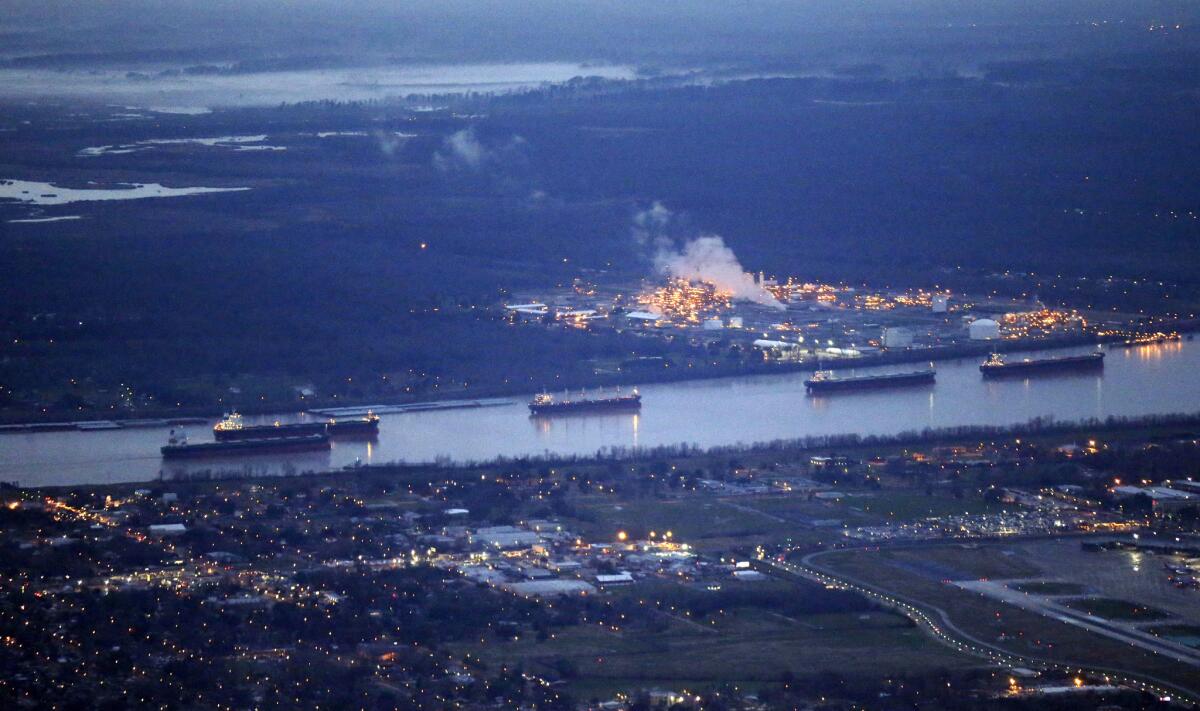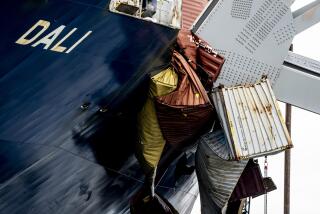Portion of Mississippi reopened after oil spill; ships still stuck

- Share via
A portion of the lower Mississippi River reopened Monday after a weekend oil spill, but another stretch remained closed, leaving 29 ships stuck, according to U.S. Coast Guard officials.
Officials had closed a 65-mile stretch of the river and the port of New Orleans after 31,500 gallons of light crude oil spilled from a barge that ran into a towboat Saturday about 50 miles west of New Orleans.
On Monday, officials reopened a portion of the river east of the spill to vessels with Coast Guard approval. Part of the port of New Orleans was also reopened as the threat of pollution there was lifted. Crews were still cleaning up in the closed sections of the river and port and investigating what caused the crash, said U.S. Coast Guard Petty Officer Matt Scofield.
Scofield told The Times that it was not clear how soon the river and port will reopen, or what the environmental impact of the spill will be.
Response crews with Environmental Safety & Health, an oil spill response organization, has strategically deployed containment boom to protect the water intakes for three parishes in the affected area. All impacted water intake facilities in the affected area are taking precautionary measures to prevent contamination. As of Monday, there are no reports of contamination to drinking water.
“All impacted water intake facilities in the affected area are taking precautionary measures to prevent contamination. As of Monday, there are no reports of contamination to drinking water,” the Coast Guard said in a Monday statement. The statement said that the Center for Toxicology and Environmental Health consulting company was monitoring for air pollution and had found no public exposure concerns. There were no signs of oil contamination to wildlife, according to the statement.
Also responding to the spill were the Louisiana Oil Spill Coordinator’s Office, Department of Environmental Quality, Department of Wildlife and Fisheries, and representatives from the governor’s office of Homeland Security and Emergency Preparedness as well as St. James and St. John the Baptist parishes.
The spill happened near the town of Vacherie in St. James Parish, and the river remain closed from there through St. John the Baptist Parish to Hahnville in St. Charles Parish, about 25 miles east. Officials in St. Charles Parish had shut down their water supply intake from the river Sunday, but reopened it again Sunday night, staff said.
In St. James, crews protected the water intake on the river with absorbent booms, and state officials were called in to monitor water quality, said Francis Hymel, the parish’s assistant director of emergency preparedness.
He said there were no reports of contamination spreading from the river.
“The majority of the oil stayed in the river itself,” Hymel told The Times.
He said Coast Guard helicopters could be seen flying overhead to check the spill, but that little was visible on shore.
“You hear ‘oil spill’ you think BP, Exxon Valdez. But this was a much smaller barge, not a spewing well,” he said, “The majority of it is being carried away by the current. It’s not that sludge washing up on shore. It’s a moving target.”
Greg Langley, press secretary for the Louisiana Department of Environmental Quality, said they responded to assess the impact of the spill and aid in the cleanup. He said cleanup crews have been placing absorbent booms in backwaters where oil has pooled, but that the spill’s impact has been small.
“The current is strong there, so we’re fairly confident it will dissipate,” Langley said of the spill. “A lot of it has probably already mixed with the water and flushed down the river.”
Officials have not received complaints about air contamination from residents or third-party air monitoring, he said.
There had been at least one report of contaminated water related to the spill in Gretna, on what’s referred to as the West Bank across the Mississippi River from New Orleans, Scofield said. Gretna officials did not return calls Monday.
Jonathan Henderson is coastal resiliency organizer with the Gulf Restoration Network based in New Orleans, a job that involves documenting leaks and spills.
“We’re concerned about the downward flow of the river and the impact of the oil on the marsh,” Henderson said of the weekend spill.
He was headed to the Vacherie area Monday to meet with responders, check river banks and size up the impact of the spill.
“If there is a threat to vessels, there is also a threat to humans, to fish and wildlife in the river itself,” he told The Times. “Just because it gets flushed from that location doesn’t mean it disappears. It goes somewhere.”
He said it will be difficult to test the water to determine the impact of the spill, given the amount of pollution along the industrial waterway, but those in Coast Guard helicopters would see it.
“With oil, you can follow the track if you can see it. The company needs to be held accountable and made to clean up that area, so it’s important to know where that oil went,” Henderson said.
The barge was being pushed by the 84.5-foot-long Hannah C. Settoon, built in 2010 and owned by Settoon Towing LLC of Pierre Part, La., according to an online Coast Guard database. The towboat involved was the Lindsay Ann Erickson, built in 1982, which is 168 feet long and owned by General Electric Capital Corp. of Irving, Texas.
There have been several oil barge crashes on the river in recent years, some much larger than the collision this weekend. The most recent was last year, when a barge carrying 80,000 gallons of oil crashed into a rail bridge, spilling oil and closing the river for eight miles in each direction. In February 2012, an oil barge crashed into a construction bridge, nearly 10,000 gallons of oil into the river. In 2008, a barge broke in half after a collision and spilled 283,000 gallons of oil into the river, closing it for about a week.
ALSO:
Man overcome by carbon monoxide dies at New York mall
What’s behind Arizona plan to let businesses refuse to serve gays?
Maria von Trapp, of ‘Sound of Music’ fame, dead at 99
More to Read
Sign up for Essential California
The most important California stories and recommendations in your inbox every morning.
You may occasionally receive promotional content from the Los Angeles Times.











